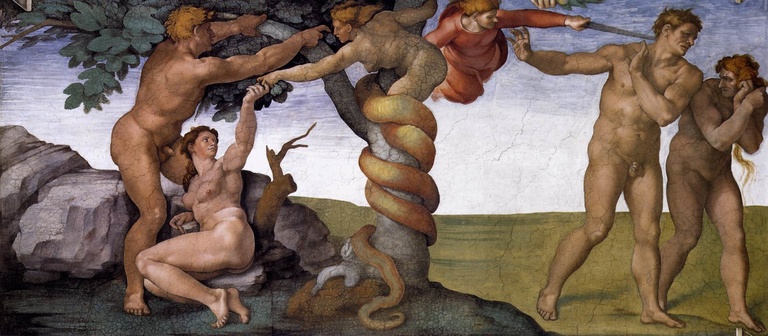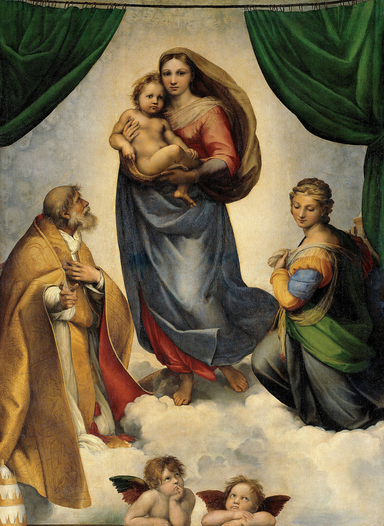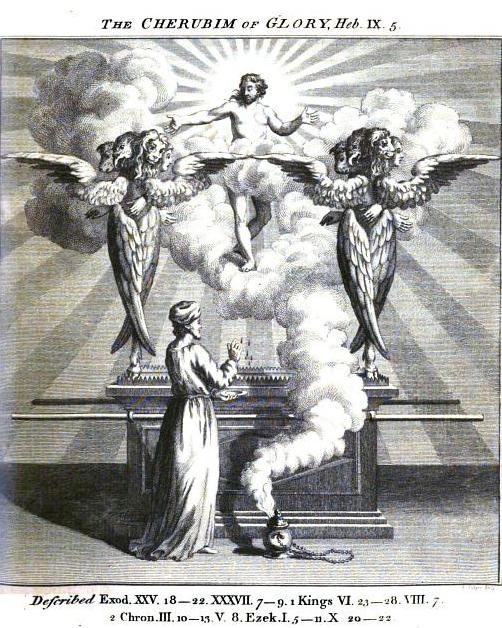Chubby babies are adorable. But no one would think to post a chubby baby as a guard to protect the entrance to anything! So why on earth did God choose a chubby baby angel to guard the Garden of Eden?
The short answer is, he didn't.
Under the influence of putto imagery popular in Italian art—where a figure in an artistic work is depicted as a chubby male child, usually naked and sometimes with wings—a cherub (Hebrew: כרוּב, pronounced ke-ROOV) often brings to mind a pudgy baby that looks like the Roman god of love, Cupid, or his Greek counterpart, Eros. It is puzzling to many, to say the least, that the Lord chose such beings to guard the Garden of Eden, even if he did also install a turning, flaming sword along with them:

"He drove out the man; and at the east of the garden of Eden he placed the cherubim (הכרבים), and a sword flaming and turning to guard the way to the tree of life." — Genesis 3:24
For all its popularity, it is worth noting that this image of the chubby baby angel is relatively recent. While there are some ancient examples of winged babies on sarcophagi (usually of children), the representation of cherubim (plural for cherub) as chubby baby angels became more prevalent in Donatello's art during the putto movement in 15th century Italy, and was then made popular during the Italian Renaissance, perhaps epitomized by Raphael's famous painting of the cherubs from his "Sistine Madonna," more commonly known as "The Madonna of San Sisto" between 1513 and 1514.

However, we must remember that cherubim in antiquity were mythological hybrid creatures that served as guardians at entrances to royal and sacred spaces—spaces that needed special protection. In the Hebrew Bible—and the Abrahamic religions in general—a cherub served the role typically played by the lamassu or a shedu in Assyrian mythology. These are hybrid mythological creatures typically depicted with a human head, the body of either a bull or a lion, and the wings of a bird. They can be found guarding the entrances to temples, throne rooms, and cities at their gates—the very roles that cherubim play in the Bible.
We have already seen that cherubim were stationed to guard the entrance to the Garden of Eden in Genesis 3:24, but they make other appearances in the Bible as well. In Exodus 25:17–22, God commands Moses to fashion two hammered cherubim out of gold—(an interesting command for a religion steeped in prohibitions against graven images!)—and affix one at each end of the mercy seat or cover of the ark of the covenant. Verse 20 says:
"The cherubim shall spread out their wings above, overshadowing the mercy seat with their wings. They shall face one to another; the faces of the cherubim shall be turned toward the mercy seat." — Exodus 25:20
So essentially, these cherubim guarded access to the throne (or at least the footstool) of God himself.

Exodus 26:1 says the curtains that formed the desert tabernacle were made "with cherubim skillfully worked into them," apparently guarding the perimeter of the holy sanctuary. Meanwhile Exodus 26:31 says the curtain that separated the holy place from the holy of holies was also "made with cherubim skillfully worked into it," again placing cherubim as guardians at the entrance to the throne room of God.
The truth is, cherubim became so identified with the presence of God that 1 Samuel 4:4 and 2 Samuel 6:2 actually describe God as, "the LORD of hosts, who is enthroned on the cherubim." Second Kings 19:15 and Isaiah 37:16 also refer to "the God of Israel, who is enthroned above the cherubim." In fact, when David sang his song of deliverance in 2 Samuel 22, celebrating his escape from Saul and all his enemies, he praises God's power by exclaiming in verse 11: "He rode on a cherub and flew!"
And of course, when King Solomon builds his temple in Jerusalem, 1 Kings 6:23–28 explains that two identical, massive cherubim, crafted out of olive wood and covered with gold (again with the graven images), were placed in the inner sanctum. 1 Kings 6:27 says:
"The wings of the cherubim were spread out so that a wing of one was touching the one wall, and a wing of the other cherub was touching the other wall; their other wings toward the center of the house were touching wing to wing."

1 Kings 6:29 says, "He carved the walls of the house all around about with carved engravings of cherubim, palm trees, and open flowers, in the inner and outer rooms," while 1 Kings 6:32 says, "He covered the two doors of olivewood with carvings of cherubim, palm trees, and open flowers; he overlaid them with gold, and spread gold on the cherubim and on the palm trees." 1 Kings 7:29 and 36 also say that cherubim were integrated into the decorations of other temple implements. So the cherubim were present within the temple's inner sanctum, on its walls, its doors, and in the decorations throughout the Jerusalem Temple to guard the sacred dwelling place of the deity. (Fittingly, Ezekiel also describes cherubim embellishing the new temple in his vision in Ezekiel 41.)
As for what biblical cherubim actually looked like, this is a bit more difficult. Beyond the fact that they possess wings, the above verses don't describe what they looked like in much detail. One of the more popular depictions was influenced by Ezekiel 1:1–14, which involved a being or beings with calves' feet, wings, and four faces: a lion, a human, an eagle, and an ox. Because God was always said to be "enthroned above the cherubim," and because Ezekiel describes the throne of God in his vision in chapter one, many artists assumed that the hybrid being described in Ezekiel's vision must be similar to the hybrid creatures they knew from Mesopotamian artwork. And, because Ezekiel 10:2 explicitly mentions the cherubim as being present above the wheel work described in Ezekiel 1:15–21, many have speculated that the vision in chapter one is Ezekiel's description of cherubim.
So it wasn't a chubby baby angel guarding the Garden of Eden; it was a fierce-looking, hybrid creature well known from other Mesopotamian artwork and literature as guardians of sacred and royal entrances.
Perhaps the better question would be why these otherworldly cherubim would require an additional supernatural flaming sword to do their job.
